Lan Xi’s Five Dynasties Makeup Look Is Absolutely Ethereal – Like a Fairy!

Recently, Lan Xi (斓曦)—the actress who played Shen Meizhuang in Empresses in the Palace—stunned fans with a breathtaking photoshoot inspired by the Five Dynasties-era painting of “Court Ladies Wearing Flowered Headdresses.” Many online commented, “Wait, this is Shen Meizhuang? I almost didn’t recognize her!”
Ⅰ. A Quick Introduction to the Actress
Lan Xi is known for her elegant, classical beauty, but she’s also gained a bit of an online discussion for her quirky fashion sense. On Chinese social media, people often joke that she doesn’t always have the best eye for picking her own outfits. There’s a picture for comparing clothes chosen for her by stylists (on the left) versus those she picks herself (on the right)—and the contrast is striking. 🤔
She rose to fame playing the gentle and noble Shen Meizhuang in Empresses in the Palace, a historical drama so iconic in China that it holds a similar cultural status to Sherlock in the UK.
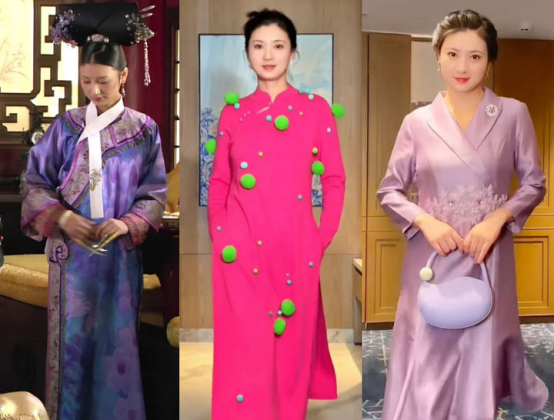
Ⅱ. The Details Behind the “Court Ladies Wearing Flowered Headdresses” Look
1. The Flower Hairpieces
Back to the topic—Lan Xi’s stunning outfit was inspired by the noble ladies in the painting Court Ladies Wearing Flowered Headdresses, traditionally attributed to Zhou Fang (though that’s still debated). In the painting, the women wear tall chignons adorned with blooming flowers, dangling hairpins, and elaborate step-shake ornaments. Their outfits typically feature wide-sleeved robe paired with hanfu hezi skirts, exuding elegance and aristocratic grace.
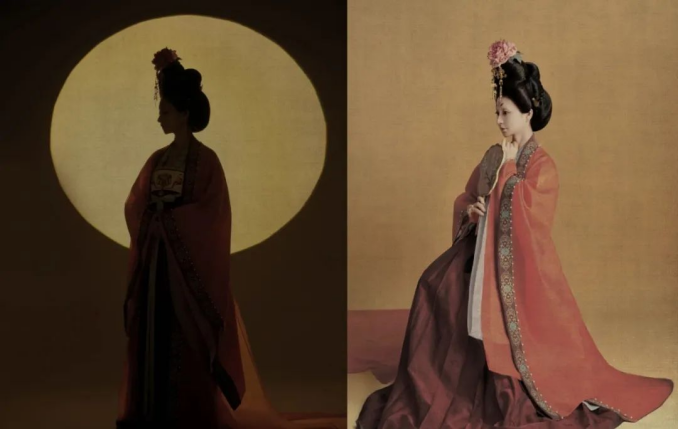
From the style and floral patterns on the clothing, this fashion is usually dated to the late Tang or Five Dynasties period. You can actually tell the difference between late Tang and high Tang floral patterns with the naked eye. High Tang motifs tend to group the petals together in a compact cluster, while late Tang and Five Dynasties patterns are more spread out, often pairing flowers with leaves in a looser, more naturalistic way. This makes it fairly easy to date the fashion in the painting—it’s definitely post–High Tang.
A closer look at the painting reveals that the women are wearing different flowers in their hair: from left to right, top to bottom, you can see begonia flowers, lotus flowers, red hydrangea, peonies, and Chinese peony. The last figure, who isn’t wearing any flowers, is actually a maid—so naturally, she doesn’t get the same hair adornments.
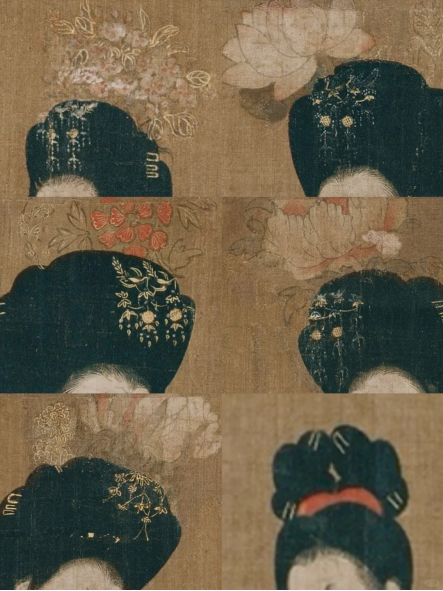
2. Eyebrows and Hairstyle
The standout features of this style are definitely the towering “e’ji” (峨髻, lofty topknot) and the distinctive “moth eyebrows (蛾眉).”

The moth wing brows became a defined style during the Five Dynasties period. These brows are short, curved, and feathered, resembling the delicate antennae of a moth just emerging from its cocoon. Their soft, arched shape gave an ethereal and refined look that was highly prized at the time.
As for the e’ji hairstyle, its name literally means “lofty chignon“—and lofty it is. These buns are dramatically high, often taller than what we see in typical historical dramas today. In fact, many depicted in period paintings or clay figurines are as long—or longer—than the length of the woman’s face.
It reflected the indulgent, ornamental lifestyle of the upper class at the time. During an era where lavish appearances often masked political instability, over-the-top hairstyles and makeup became a symbol of aristocratic luxury and escapism.
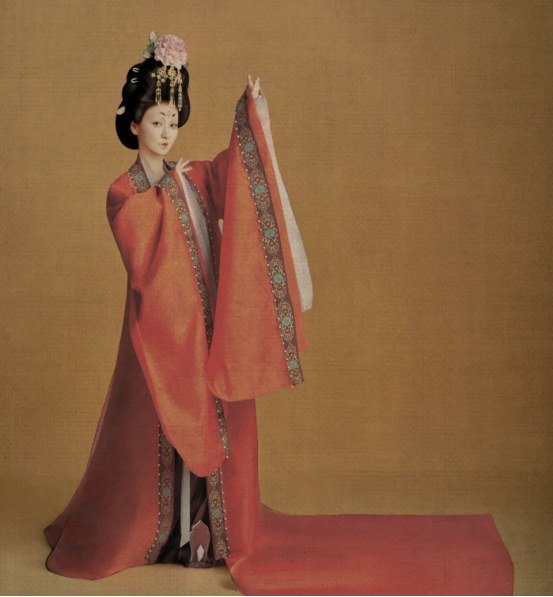
3. Theories About the Painting’s Historical Origins
Interestingly, the grand e’ji hairstyle didn’t always go hand-in-hand with large floral headpieces. In fact, according to renowned scholar Shen Congwen, the elaborate flowers seen in Court Ladies Wearing Flowered Headdresses may have been added later by a Song dynasty artist.
Shen noted that the women in the painting already have full, voluminous hair adorned with gold and jade hairpins and dangling ornaments. To then add oversized flower crowns would feel visually mismatched and out of place—something almost never seen in genuine Tang dynasty artwork.
Supporting this theory, many clay figurines from the Five Dynasties period show women with e’ji hairstyles decorated only with hairpins or smaller floral touches. If flowers are present, they are usually dainty and arranged subtly—not perched like a single oversized bloom on top of the head.
Because the Song dynasty followed closely after the Five Dynasties, it’s quite possible that Court Ladies Wearing Flowered Headdresses was created during the Song period, with the floral adornments reflecting a romanticized reinterpretation of late Tang or Five Dynasties aesthetics.
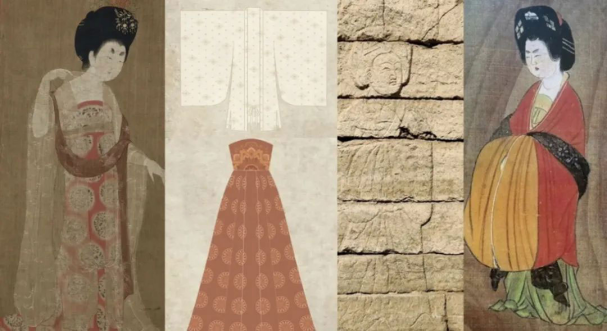

In the fashion of the Five Dynasties and Ten Kingdoms period, one of the most popular formalwear combinations for noblewomen was a large-sleeved robe paired with a hezi skirt. This Chinese outfit was widely worn for ceremonial occasions.
While the exact structure of the hezi skirt remains unclear—some believe it was a two-piece set (a hezi top plus a separate skirt), while others argue it was a one-piece design—what is clear is that this style reflected the elegance of aristocratic dress at the time. Archeological findings have even revealed robes with a high-low hem (shorter in the front, longer in the back), likely used in formal settings.

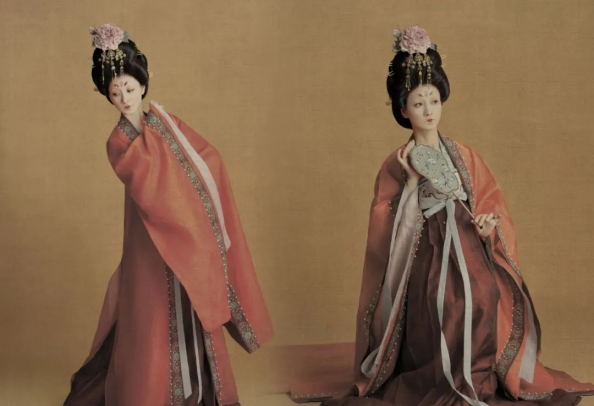
Court Ladies Wearing Flowered Headdresses has become an iconic representation of how women from the late Tang to Five Dynasties era may have looked. Its influence is so strong that it even shaped the aesthetic for early Tang-style period dramas.
The high bun, slender curved brows, and delicate “tiny lip” makeup in this look all serve to dramatically reshape the appearance of the face—fitting the extravagant and ostentatious beauty trends of the late Tang and Five Dynasties. No wonder so many viewers said they could hardly recognize the actress Lan Xi, best known for her role as Shen Meizhuang in Empresses in the Palace.
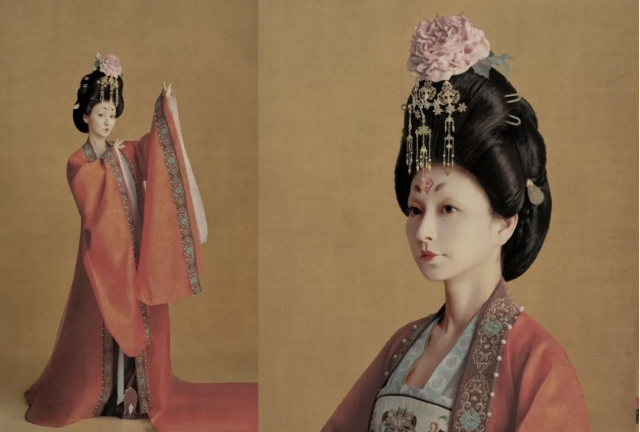
Summary
The Court Ladies Wearing Flowered Headdresses vividly depicts the leisurely and idle lives of noble ladies in the Tang Dynasty, who spent their days amusing themselves among flowers, butterflies, cranes, and dogs. It’s the only recognized surviving solitary copy of Tang – Dynasty paintings of ladies – in – waiting worldwide.
Using this painting as a reference for restorationreference is truly excellent, and the attention to detail is remarkable. The actress Lan Xi’s facial features are perfectly suited to classical makeup, making her seem like a figure stepping out of the painting.
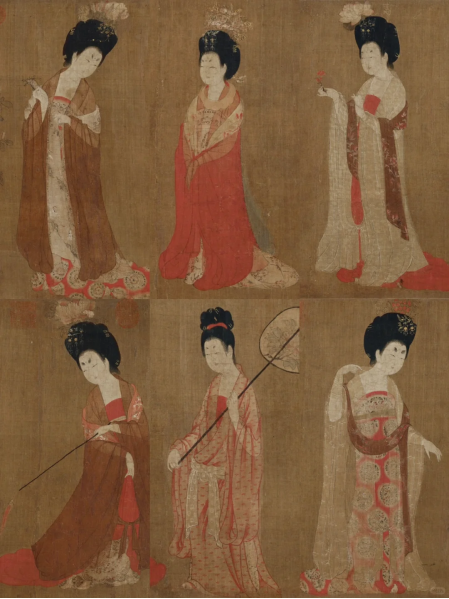
More and more film, television works, and graphic designs are incorporating traditional Chinese clothing elements nowadays. This reflects respect for and promotion of classical culture. The more we explore Hanfu, the more we realize that ancient people’s aesthetic sense was no less sophisticated than that of modern people. Besides Lan Xi, we’ve previously discussed Chen Duling’s and Yang Zi’s Chinese – style makeup looks. We look forward to seeing more exquisite Hanfu makeup in the future.
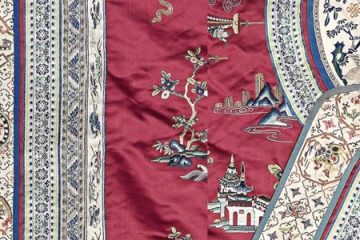
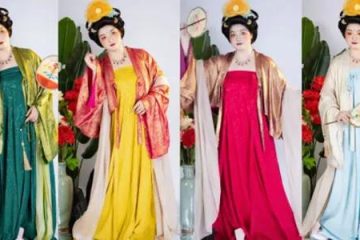
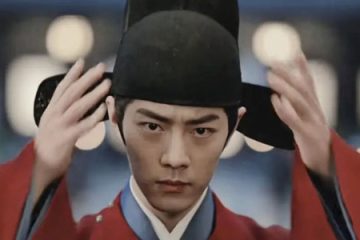
0 Comments